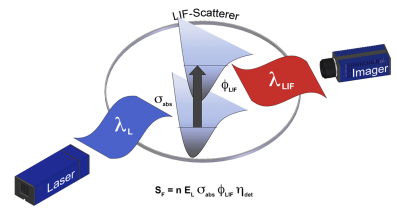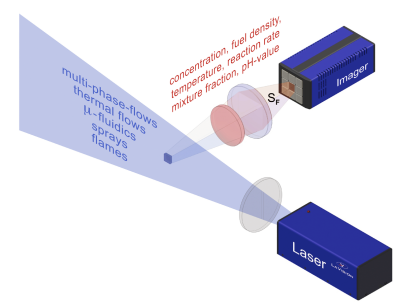Laser Induced Fluorescence
Planar Laser Induced Fluorescence (PLIF = LIF Imaging) is a very sensitive laser imaging technique for species concentration, mixture fraction and temperature measurements in fluid mechanical processes, sprays and combustion systems. LIF imaging is a molecule specific visualization method with high spatial and temporal resolution. If the fluid itself contains no LIF-active species (like N2, CH4 or water), flow seeding with fluorescent markers (tracers) is used for scalar flow field imaging (Tracer-LIF).
LIF Principle
LIF Principle LIF is a two step process: absorption of a laser photon followed by emission of a fluorescence photon from the excited state. For absorption the laser wavelength %lambda%L must match an allowed energy transition of the LIF-active molecule (atom). Only a fraction %phi%LIF of these excited molecules fluoresces, the rest relaxes without light emission. An optical filter selects the usually red-shifted fluorescence light at the emission wavelength %lambda%LIF. Only the fraction %eta% of all emitted LIF-photons is detected and converted to the camera signal SF.



LIF Imaging Setup
A laser beam is formed to a light sheet (or volume) and intersects the fluid area of interest, e.g. in flames, sprays or thermal flows. The resulting fluorescence light from excited molecules in the light sheet is imaged through a selective filter onto a time-gated digital camera. For pulsed UV LIF applications usually an image intensifier amplifies the LIF signal. The conversion of LIF images into meaningful concentration or temperature fields is based on calibration measurements.
LIF Advantages
LIF is a technique with high selectivity. It is possible to selectively address species to emit light even in combustion environments where hundreds of different species are present. For small, typically diatomic molecules single quantum states can be detected which allow to determine gas temperatures even under non-equilibrium conditions.
Due to the spectral shift of the LIF emission unwanted interferences from stray light or Mie scattering can be effectively suppressed.
LIF imaging is particularly attractive due to the strength of the resonant absorption process compared with the non-resonant Rayleigh and Raman techniques Due to this sensitivity, techniques like LIF has the capability to detect flame radicals and other species at the ppm or even sub-ppm level. Sensitivity and selectivity are the two main advantages of the LIF technique.

